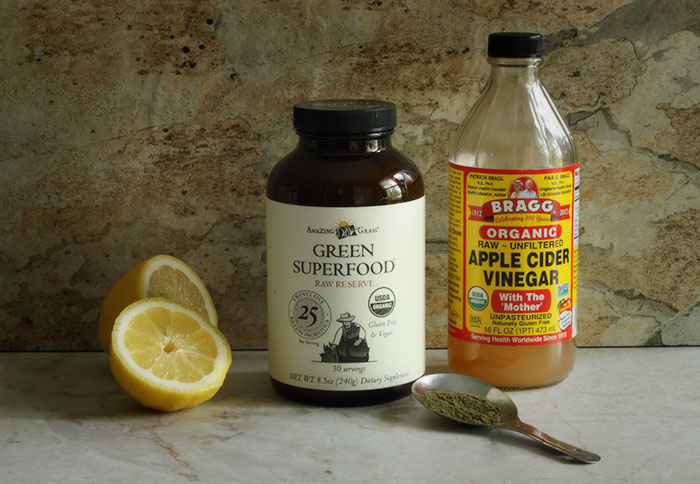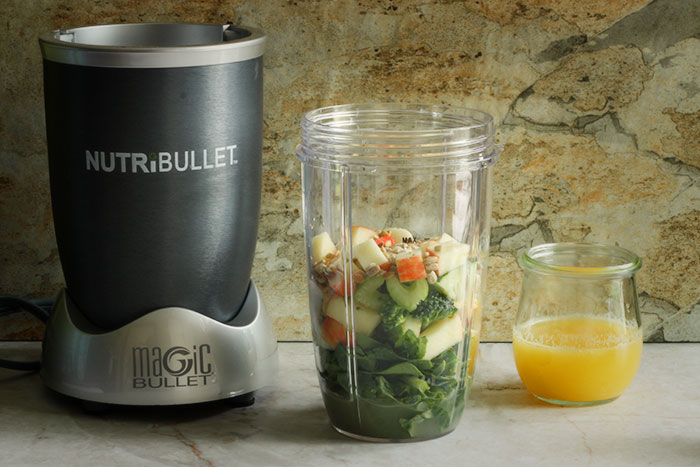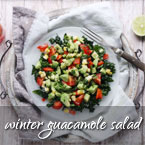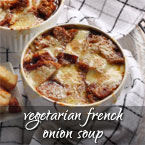Why green juicing rocks

When I decided to follow a vegetarian diet two-plus years ago, it wasn’t for health reasons. So, my new way of eating wasn’t the healthiest — not terrible, but not a model of vegetarianism, either. Pasta was the automatic substitute for meat dishes. And when all else failed, there was bread. I consumed plenty of whole vegetables and fruits — I always have, actually — but replaced animal protein with lots of carbs in the process. I neither gained nor lost weight (although my cholesterol levels — which were already good — improved further, as did my blood pressure. A ringing endorsement, I think, for cutting back or giving up meat).
It was an easy transition, eliminating animal products, but over time, I realized I just wasn’t feeling as I should. Problems that were minor or infrequent eventually became nagging, annoying, concerning. I blame that on aging — not vegetarianism — I knew I had to make a change.
I began green juicing more or less to do a full-body “reset.” Some of the issues I was experiencing are better left for another post (marked, “Girl stuff”), but others, like bad skin (life-long rosacea, adult acne and dry, flaky skin), aching joints, an autoimmune disease that could fire up at any moment, persistent heartburn and digestive issues … I wanted relief — I wanted to just feel better — but I didn’t want to turn to western medicine (which tends to patch rather than fix, accumulating pill after pill in the process).
There’s certainly a lot of hype out there — a lot of hype — about eating a vegetable-strong diet, but some of it made sense to me. Particularly, that the health of one’s body, and the normal functioning of the immune system, begins in the gut and digestive tract, and that inflammation is the enemy.
I’ve written before about gluten, and the fact that I’ve cut back considerably on my daily consumption of it. That, alone, has made a difference in how I feel, every day — a big win against inflammation, which gluten is known to promote.
Fresh vegetable juice and green smoothies (sans dairy) have been the icing on the cake. This has been my personal project for 2013, so I thought I’d share the ways I’m getting more vegetables into my life — in liquid form — and what the effects have been.
(As with all things health-related, do not take one person’s experiences as a rule of law — consult your trusted medical advisers before radically changing your diet, especially if you take prescription medications.)
Green Juicing
If it wouldn’t completely kill all credibility of subjectivity and levelheadedness, I’d film a video of me running around the kitchen in circles like a 4-year-old hopped up on Twinkies, hugging my juicer to my chest. (Also, it would go viral for all the wrong reasons — “See 40-something woman go crackers on green juice!” — and I’m pretty sure it wouldn’t help the cause.)
But, that’s how I feel about my juicer. Green juice has been a transformative influence, and I’m very grateful that I hit the “Add to Cart” button late one night, after two friends gushed about their new juicer. I worried it would become another appliance in the cabinet that I can’t reach without a step ladder; instead, it’s my daily tool to feeling better.
The best benefit of juicing is that it has completely reset my appetite. I no longer crave sugary, fatty foods (and honestly, they don’t even look particularly tasty to me anymore). I eat smaller portions at meals without feeling deprived. I didn’t even do a real juice fast — I just started drinking green juice between meals and at bedtime. The changes occurred slowly, almost imperceptibly, until I realized all at once that I wasn’t going back for seconds at dinner, and I wasn’t craving ice cream at night.
Other effects began to accumulate as well. I will never have super-model-smooth skin — not even laser treatments or plastic surgery will give me that — but my skin has cleared considerably, especially the rosacea. I used to get heartburn every morning about an hour after awakening. No more. I sleep well, and wake up refreshed. I’ve plowed through spring’s labor-intensive gardening tasks with great energy.
I know all of the arguments against juicing — particularly about the extracted pulp — so I’ve approached the whole thing as sensibly as I can. I drink freshly pressed green juice almost every day, but I do other things as well (below), including consuming more than the recommended daily allowance of whole vegetables.
I use very little fruit — just apples and lemons — to keep sugar rushes at bay (and avoid the calorie bombs of typical fruit-heavy smoothies). I alternate the greens and vegetables I use to get a wide range of nutrients.
I use lemon juice in every drink I make — it’s reported to cleanse the liver as well as to have an alkalizing effect on the body — and often add a splash of raw apple cider vinegar (which has a slew of health benefits of its own).
For folks worried about the taste … and concerned about the intimidating greeness of the drink … it’s really delicious. The flavor is controlled by the vegetables you add, not so much the leafy greens that contribute the color. I never notice the kale or spinach, but do notice the balance of carrots, cucumbers, ginger, and apple. You can’t go wrong if you use the vegetables you love.
And if you’re not a fan of the bottled green drinks by companies like Naked and Odwalla, take heart: I don’t like them either. (One of them, I can’t remember which, has garlic, and I can taste the garlic. It’s just not my cup of tea.) Fresh green vegetable juice tastes nothing like what’s on the commercial market (not even the salt-laden V8 juice).
My favorite green juice is a based on a widely-shared recipe: 5 or 6 kale leaves, a big handful of spinach, 1/2 of a lemon (peeled), 1 Honeycrisp apple, 1/2 of a cucumber, 2 stalks of celery, 1 small carrot, and a 1″ piece of ginger. (My homemade V8 juice rocks the party, too: to the above, add a handful of cherry tomatoes, a red bell pepper, and another carrot.)
Pros of juicing:
- Delicious — it’s pure vegetable essence, so you don’t need additives like salt or sugar.
- Fresh juice is loaded — I mean, loaded — with vitamins, minerals, and micro nutrients.
- Numerous, healthy side-effects. I imagine they’re different for everyone, but my skin has cleared considerably, I have good, steady energy throughout the day and sleep well at night, and my digestive system has calmed noticeably.
- Consuming at least 16 ounces of green juice a day has reduced my sugar cravings to almost nothing. Rich desserts don’t even look good to me anymore.
- It’s versatile. Most vegetables and fruits can be juiced — the recipe possibilities are endless and it’s never boring.
- For folks who have trouble consuming enough vegetables in a day, you can drink an entire bowl’s worth of vegetable nutrients in one glass.
- It stores well overnight. I fill a small thermos to the top to minimize air in the container.
- Unlike smoothies, green juice doesn’t need reblending, so it’s portable.
- Some juicers (like mine) can produce nut milk, which is a very delicious alternative to dairy and soy. (Pistachio is my favorite.)
Cons:
- It’s time-consuming. Depending on your recipe, the entire process can take 30 to 60 minutes.
- Juicing requires a lot of vegetables. A lot.
- Pulp and fiber is removed during the juicing process. (I compost my pulp, but there are recipes online to use up the pulp.)
- Some juicers are harder to clean than others. My Hurom Slow Juicer
has just a few parts, but, I must clean them immediately — no procrastination. Dried vegetable matter in the filter basket would be dreadfully difficult to clean.
- Because of the pulp removal, some nutrition experts advise that, no matter how many glasses of juice you drink per day, it still counts only as one vegetable serving.

Vegetable Powder
Vegetable powder was an accidental discovery. I was browsing through the health section at the grocery store, and impulsively grabbed a can of wheatgrass powder. I really had no intention of drinking it straight-up — I thought I’d add it to my green juice. That worked fine: I couldn’t taste it in the juice, and I got the extra nutrition benefits.
After some further research, I decided I wanted something that contained chlorella, a fresh water algae rich in chlorophyll (fights inflammation), vitamins, minerals, and amino acids. I stumbled upon the Green SuperFood Raw Reserve brand on Amazon, and have been quite happy with it.
The flavor is much better than wheatgrass (although still, you know, very grassy), and it takes the pressure off of daily green juicing. I consume at least one glass per day, using this recipe:
2 teaspoons vegetable powder
1/2 teaspoon magnesium (about 100 mg – at night only)
juice from 1/2 of a fresh lemon
1 tablespoon raw apple cider vinegar
8 ounces coconut water or freshly pressed apple juice
Pros of vegetable powder:
- Super convenient. Mix, stir, drink. It doesn’t get any easier than this.
- The brand I use contains an insane number of green nutrients, including wheatgrass, spirulina, and chlorella, plus probiotics (a big plus).
- You can add the powder to any drink, including your vegetable juice (above) and your Nutriblasts (below).
- Did I mention it’s really, really quick? This powder makes certain I never go a day without an extra boost of green nutrition.
Cons:
- The flavor isn’t particularly great straight up in water, which is why I came up with the “recipe” I use (but is also fine just mixed in orange or apple juice).
- The brand I use is a bit upfront pricey, but it does last for a couple of months.
(In the interests of full disclosure, if you make a purchase on Amazon via the links in this post, I get a teeny-tiny commission that will likely not be paid until sometime next year. But when it is, it will be funneled back into the costs of maintaining this site. And I’ll be ever so grateful that you clicked.)

Nutribullet
This was sort of an impulse, discount-I-couldn’t-pass-up purchase. I wasn’t seriously looking to buy one, but I got a fantastic deal — given the equipment I already own, I would not have paid full price, or even a run-of-the-mill sale price.
Bullet blenders, like the Nutri Bullet, are small units with a double-row of sharp chopping blades and a fairly powerful motor. You load the ingredients in the provided container — taking care to respect the Max Fill line — attach the blade base to the opening (it screws on easily), then invert and insert the unit onto the base, pressing down and twisting clockwise to lock in place. This twisting activates the blades when the base is plugged in. To halt the blending, twist the container/blade unit counter-clockwise. Up-end the unit, remove the blade base, and you’re drink is ready.
If you have a mega blender, such as a Vitamix or a Blendtec, you definitely don’t need a Nutribullet. You have all the power and chopping speed you need to make green smoothies, just in a larger appliance.
It does, however, perform better than my standard blender. My blender doesn’t completely break down leafy greens, so there are always flakes of spinach and kale in my green smoothies. The Nutribullet breaks everything down quite well.
I’m surprised how much I enjoy the convenience of it. Everything about it is fast, from the blending — just two 15-second pulses do the trick — to clean-up.
If you balance your ingredients, the drink is quite substantial — it’s a satisfying meal replacement. Since I don’t use dairy in my smoothies, the drink stays well-blended, and can store in the fridge overnight, or be transported for later consumption. (I’m personally not concerned about nutrients breaking down after hours of storage — I figure a fresh[ish] green drink is better than most of my other options, especially at work.)
Feedback comments on this unit at various online stores reveal a few problems, and an unsatisfactory product life. The unit will readily leak if you exceed the Max Fill line (easy to obey, though — I bow down to the great and mighty line, and haven’t had a leak). The unit loses power over time (although it’s not clear if it’s a blade issue, or a motor issue). And numerous people have reported back that the unit died within a few months. The manufacturer’s customer service is said to be fairly uncooperative, so I’m hoping I’ll be able to return it to the retailer instead. (Yes, I’m already braced for the unit to fail. Sadly.)
Lots of stuff comes in the box — stuff that is more of a nuisance to store than anything (but since I’m keeping the box for the inevitable return, they just live in the box). I wouldn’t trust the included lids to be leak proof. The smaller of the two containers is ridiculously small – it holds barely anything. Kid-size, I’m guessing. There’s a snap-on handle for both large and small cups — good for kids; I just find it bulky. Neither cup fits a standard car cupholder. The milling blade looks interesting, but I haven’t used it yet. The recipe book is a useful read. I don’t really use any of the recipes — they’re too fruit-heavy for my tastes — but they gave me ideas that lead me to the mix I use most often (below).
Despite these weird negatives, I really do like the unit. I appreciate the convenience and speed of prep, taking only a few minutes to slice up the small amount of vegetables that fit in the large container vs. the 15 to 20 minutes it takes prep all the veggies for my juicer.
My favorite Nutribullet recipe:
1 large kale leaf, torn into several pieces
1 palmful spinach, torn into smaller pieces
1/4 Honeycrisp apple, cubed
1/4 cucumber, cubed
a small palmful of other veggies I might have on hand, such as celery or broccoli
a small palmful of sunflower seeds
1 tablespoon raw apple cider vinegar
juice from 1/2 of a lemon
coconut water or apple juice
Pros:
- Blends really, really well.
- It’s fast. Two 15-second pulses liquifies everything.
- Unlike juicing, the whole vegetable is preserved in the drink – it contains the pulp and the fiber and all the goodness therein.
- The large size container produces a decent meal replacement.
- If you don’t include dairy, the drink remains well-blended and is, therefore, transportable.
- Compared to juicing, vegetable prep is pretty fast, since you’re using a small amount of veggies
- Clean up is really fast. Just rinse the blade unit, and wash the cup with soapy water, and you’re good to go.
Cons:
- I’m concerned that the unit won’t last.
- Blended — as opposed to juiced — vegetables need extra liquids added, or else they would become a pesto. This produces a less flavorful “watered-down” drink than juicing (and is one of the reasons I prefer juicing).
- The recipes in the booklet rely on fruit to give the concoctions — the “Nutriblasts” — decent flavors (kudos, though, that they don’t resort to yogurt or milk). I don’t like to use as much fruit as they recommend, so it took some time for me to develop a vegetable-heavy recipe I liked with ingredients that counteract the liquids that have to be added.
- The extras that come with it are kind of silly.
And so, you now have a glimpse into my daily vegetable routine. I use the three processes interchangeably, and sometimes together (while green juicing, I usually make a point to also juice some apples, which I use with both my vegetable powder drinks and Nutriblasts).
If anyone would like to share their experiences with green drinks and/or equipment, I’d love to hear them (successful or not)!

Comments:
Comments are closed.












I think this is a great way to get in a serving of veggies. But as a nutrition professional, I do agree that its lacking fiber which is incredibly important for digestive health. In addition, some of the nutrients found in veggies aren’t as available to be digested when raw – like tomatoes for instance – so it’s good that you include veggies in other aspects of your diet.
I’m fascinated by your post, thanks so much for explaining everything in such detail. Very intriguing, and inspiring!
What type of juicer do you use?
I have a Hurom Slow Juicer, which is a masticating model. It’s the only juicer I’ve ever owned, so I have no means of comparison, but I do like it. It’s efficient, and is easy to put together/take apart.
I just love green juice. It’s such a great way to get in nutrients during my busy days, and it tastes great too!
What a wonderful and informative post! There is only one thing I just can’t agree with and that is that juicing is time-consuming and it can take 30 to 60 minutes. My husband and I do a lot of juicing (he’s done juice fasting many times, last summer for up to 30 days) and I’d never spend more than 10 to 15 minutes on preparation, including cleaning the juicer. It might be that I’m used to the routine (I’ve done it for years now) or the brand of juicer I have (I use Breville) but also, if you clean the veggies and fruits well, you can skip peeling, coring or even cutting them. Then it’s super easy and fast!
I started juicing almost daily about 2 months ago. I also had issues with rosacea, and had almost given up finding a solution. Not only has that cleared up dramatically, but the amount of pure ENERGY you get from green juice is amazing! Thank you for the review, I wish more people would try it!
Can you tell me what you juice that helped your rosacea? Thanks bunches
Thank you – This is a really thorough and informative post. Thanks for sharing your thoughts and experience! I have recently started juicing (purchased the Oscar 900 and love how it juices everything, especially greens) & it’s great to read about other people’s recipes. I saw the Nutribullet on late night TV one night and thought perhaps I had made the wrong decision buying my juicer, but I too was a bit concerned that the unit would last as long as a high powered blender. I juice in the morning before work and it takes about 10 minutes to prepare a green juice for two people. I have everything pre-washed in a big container in the fridge and all I have to do it chop it up and put it through the juicer. I think that the larger centrifugal juicers are a huge hassle to clean – but because there are only a few small parts to wash with my juicer it takes me all of about two minutes to wash everything thoroughly.
I have juiced on and off for years. The reason I go off it is because I turn green with green juice and orange with carrots. I also seem to become allergic to some of the veg, getting bad headaches and feeling quite poorly. Anybody got any ideas what is happening?
Get all the Norman Walker books. They are incredibly helpful when it comes to juicing. You are probably just detoxing. The discoloration should eventually go away as well as the symptoms.
Informative article^^
I don’t do veggie juice but ‘veggie blend’, I should say, lol, since I use my practical, efficient, strong, wonderful hand blender to make it (Neo Tokebi hand blender, made in Korea). The blender makes veggie blend, which means I drink/eat every part of the veggies, the pulp and juice. It’s almost like puree, I think. It only takes a minute to blend a mix of veggies (a glass of veggie blend), and 10 seconds to clean it up, and 10 minutes to chew and gulp it down
My favorite is a mix of beetroot/carrot, broccoli, celery, tomato, paprika, mint, cucumber and spinach. I don’t mix beetroot with carrot because I read somewhere that it’s not good to mix them.
I love this sure, it’s so helpful and motivating
Nicolle